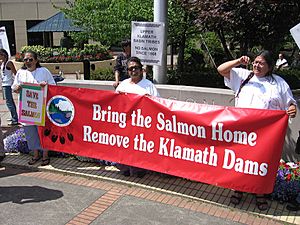Klamath River Hydroelectric Project facts for kids
The Klamath River Hydroelectric Project is a group of dams and other buildings on the Klamath River. This river flows through parts of California and Oregon. These dams help create electricity.
The first parts of this project were built starting in 1903. A company called California Oregon Power Company, or "Copco," built them. Today, a company called PacifiCorp owns and runs most of these dams. They make up to 169 megawatts of electricity.
Some of these dams are planned to be taken down. This is happening because of agreements about water rights and the health of the river.
This project is different from the Klamath Project. The other project uses dams mainly to store water for farms.
Dams of the Klamath Project

Most dams in this project belong to PacifiCorp. The Link River Dam is owned by the U.S. Bureau of Reclamation. All dams are on the main Klamath River, except for Fall Creek Dam. Fall Creek Dam is on a smaller river that flows into the Klamath.
Here are the dams in the project:
- The Fall Creek Dam was built in 1903. It is north of Copco Dam #2. This dam was built to make electricity.
- The Copco Dam #1 was finished around 1916. It was made bigger in 1922. The Copco Dam #2 was finished in 1925. Both dams make electricity. Copco Dam #1 creates Copco Lake.
- The Link River Dam was finished in 1921. Its main job is to control floods and store water. It also helps make some electricity. This dam creates Upper Klamath Lake.
- The John C. Boyle Dam was finished in 1958. It makes hydroelectric power. This dam creates the John C. Boyle Reservoir.
- The Iron Gate Dam was finished in 1964. It helps with flood control and makes electricity. It is the tallest dam in this group. It is also the furthest downstream.
- The Keno Dam was built in 1967. This dam does not make electricity. It creates Lake Ewauna.
Why Remove Dams?

For a long time, there have been disagreements about water rights in the Klamath Basin. To solve these issues, many groups signed an agreement in 2008. These groups included the states of California and Oregon. Three Native American tribes also signed, along with counties and other local groups.
At that time, PacifiCorp needed to get new permits for its dams. This process would have been very expensive. They would have needed to fix problems for salmon to pass the dams. They also needed to deal with harmful bacteria growing in the Copco and Iron Gate Reservoirs.
In 2009, PacifiCorp agreed to remove four dams. These were the John C. Boyle Dam, the Iron Gate Dam, and Copco #1 and #2. This plan needed approval from the United States Congress.
Congress did not approve the plan. So, in 2016, a new agreement was made. The states of Oregon and California, the dam owners, and other groups agreed. They decided to remove those four dams by 2020. This plan only needed approval from the Federal Energy Regulatory Commission. The governors of California and Oregon supported this new plan.
Images for kids
-
The Link River Dam in May 1938.
-
People asking for dams to be removed from the Klamath River.


